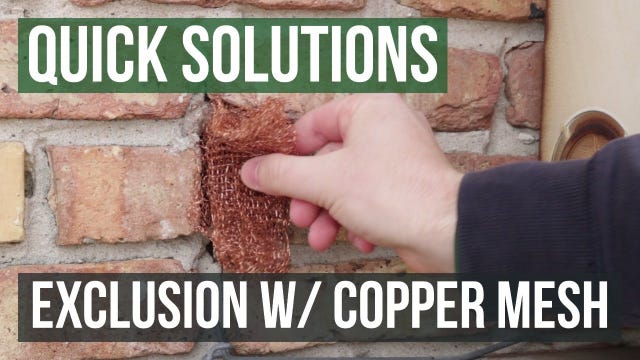Gain access to personalized product screening, the best pricing, rewards, and more!
Most Effective Products
Exclusion With Copper Mesh
Often, the best way to deal with pest control problems is to prevent them from happening. Exclusion is more stressful in preventing rodents and insects from settling in your home. Exclusion is a safe way to prevent and keep unwanted animals, insects, and rodents from your home because it often doesn’t involve using chemicals. One important technique to reduce the chances of rodents coming into your home is exclusion with copper mesh.
At Solutions Pest & Lawn, we carry professional copper mesh exclusion products. The best thing about this product is that you don’t need to be a professional to apply it to your home; it is easy for any DIYer to pull off. On this page, we will inform you about the copper mesh exclusion technique, the benefits of using copper mesh, and how to apply the mesh properly. You can also shop for our copper mesh products here.
What is Copper Mesh?
Copper mesh is a highly flexible and versatile material. It involves a soft copper material woven in such a way that it creates a sort of wire fence. Because copper is a softer metal, it is used for a variety of different reasons.
Copper wire mesh is ductile, flexible, and has high thermal and electrical conductivity. Although it is softer than a similar stainless steel wire mesh, it is also resistant to corrosion from various elements and compounds.
Aside from pest control exclusion, copper wire mesh is a popular option for many industries, including designers, artists, architects, electricians, and homeowners. Homeowners and designers use copper mesh for residential projects, including gutter guards, soffit screens, insect screens, fireplace screens, or even custom-manufactured infill panels or decorative wall panels.
Conditions for Applying Copper Mesh
Exclusion is a homeowner’s first line of defense against a rodent infestation. The idea behind this integrated pest management tactic is that it’s much easier (and safer for the environment) to keep pests out than to attempt to eliminate an infestation once it takes hold. Unfortunately, because rodents are small and sneaky, many commercial buildings and residences have plenty of points for rodents to gain access indoors by squeezing through cracks, holes, plumbing pipes, and other openings, which can be doorways for rats and mice.
Copper mesh is an excellent way to prevent rodents from crawling into tight spaces. By stuffing copper mesh into holes, openings, and other possible points of entry, rodents cannot crawl through and will have to go elsewhere to find a place to gather and cause destruction. It’s also difficult for rodents to chew through and destroy.
Benefits of Copper Mesh
There are several advantages to using copper mesh as a means of exclusion. Here are just a few of the reasons why it's such a vital exclusion tool:
- Flexibility: Copper mesh's moldable and adaptable properties make it simple to incorporate and work with. The material can be formed and fitted into tight spots to fill voids.
- Quality: Although delicate, copper mesh can withstand harsh conditions, allowing it to endure and last a long time.
- Water-resistant: Copper mesh can be installed outdoors or in water because moisture does not damage or alter it.
- Low thermal expansion: Copper has high electrical conductivity but is also highly tolerant of heat and works well in maintaining shape and volume.
- Bacteria-free: bacteria do not grow on this kind of mesh, which is an especially important factor for those who are health conscious and don’t want a health hazard
- Sturdiness and simple upkeep: Copper mesh structures last a long time and don't require special maintenance measures.
Drawbacks of using Copper Mesh
There are really not any noteworthy drawbacks to using copper mesh. It is affordably priced, easy to use and apply, durable and long-lasting, and gets the job done right to keep rodents, birds, and other insect pests out.
Our Recommendation
Stuf-Fit Copper Mesh—Stuf-Fit is an important part of rodent exclusion because it's made of the finest ingredients, such as brass, copper, and other inert metals. It is rustproof and stainproof and works great to seal weep holes around plumbing, A/C, vents, and other places where rodents and insects enter.
User Guide

Step 1: Preliminary Inspection
Start by inspecting the home to see where you could find gaps and holes where the copper mesh would be useful.
Step 2: Pull out and Measure Mesh
Pull out the roll of copper mesh and snip off the amount you need for a gap or opening.
Step 3: Apply Mesh
Crumple up the mesh and work it into the opening to essentially create a barrier that rodents won’t be able to go through. You may need to use an instrument such as a stick to help you shove the wool in tighter gaps. And that’s it! Repeat all gaps and openings until your entire home is covered.
Key Takeaways
- Copper Mesh is an excellent exclusion technique for keeping rodents from sneaking into points of entry in your home.
- Copper mesh is affordable and durable. For the best results, it should be placed around the exterior of the home, particularly around plumbing.
- Our top recommendation for this technique is Stuf-Fit copper mesh.







